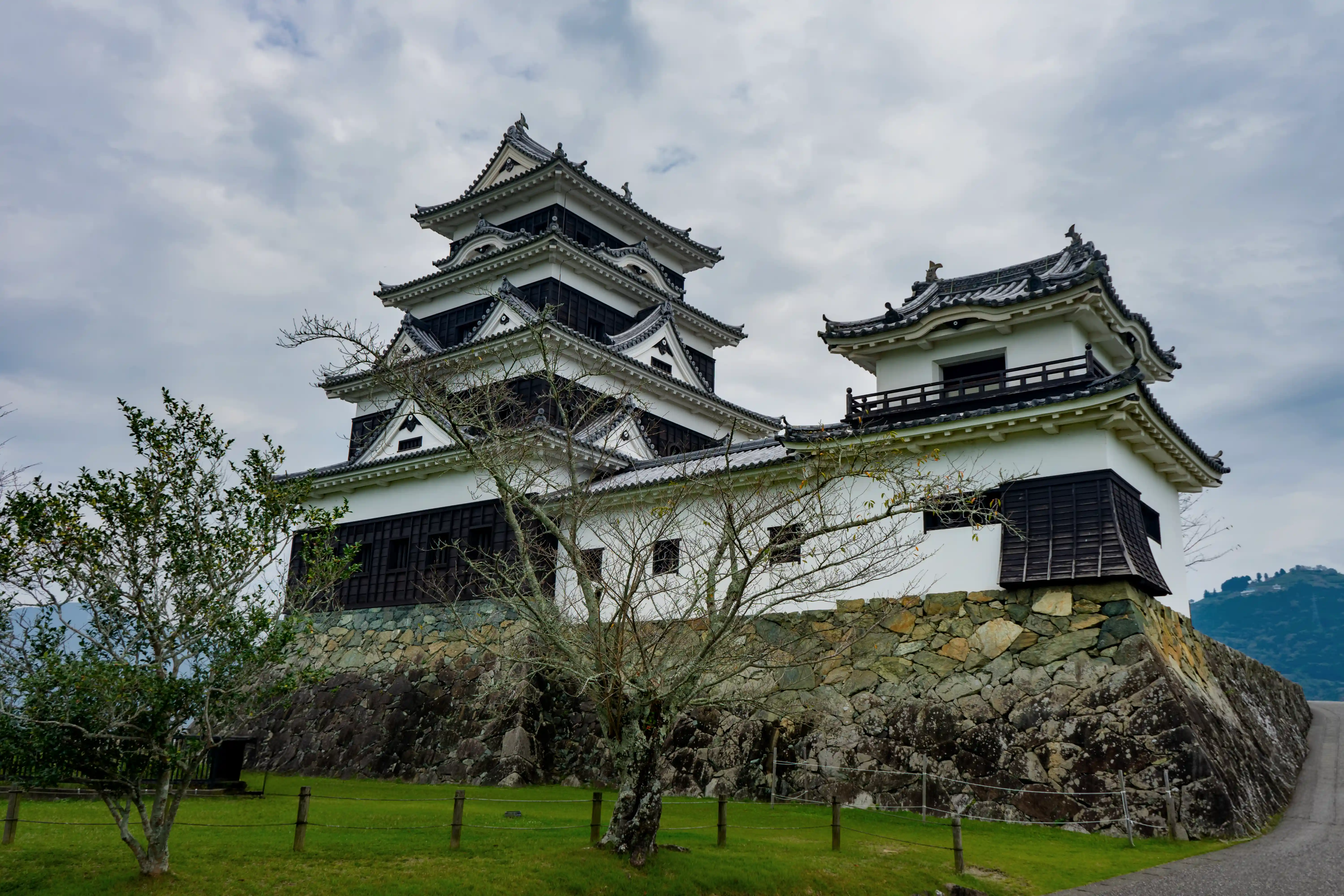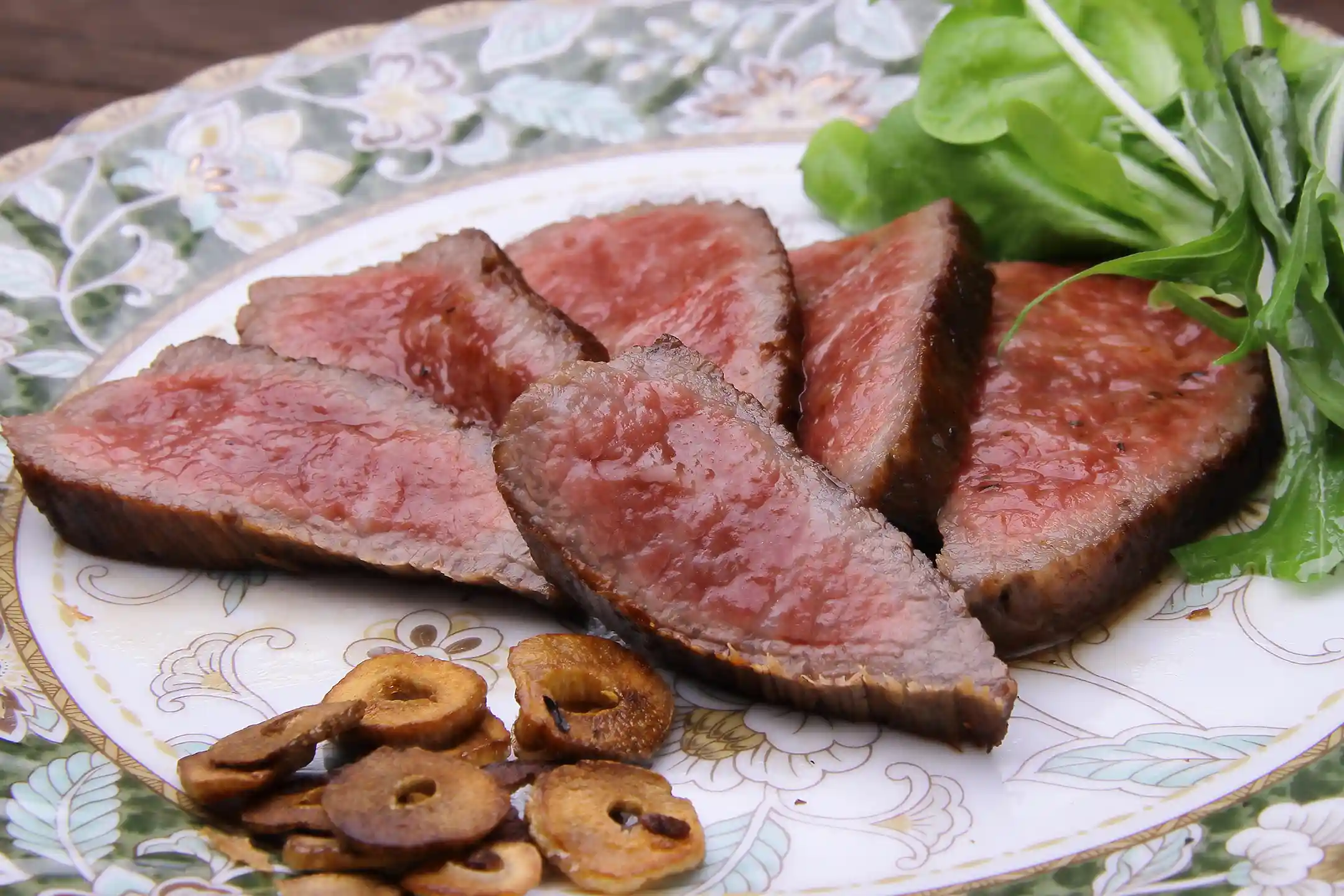Ozu Castle is impressively reflected in the tranquil waters of the Hijikawa River, symbolizing the essence of Japan’s historic castle architecture. Unlike the predominantly stone-built castles you might know in the West, Ozu Castle’s wooden keep stands proudly against the blue sky, presenting a uniquely Japanese aesthetic. When you see this scene for the first time, it will likely stay with you, imprinting itself like a picturesque painting in your memory.
The stories crafted by figures like master castle builder Todo Takatora and the feudal lords of the Kato family are still very much alive in Ozu—you can sense Edo-period cultural heritage throughout the town. Join us as we explore Ozu Castle’s captivating history and highlights that transcend cultures.
History of Ozu Castle: Lords, Legends, and Cultural Heritage
Ozu Castle’s story begins in the late Kamakura period. In 1331, Utsunomiya Toyofusa, the guardian of Iyo Province, built a fortress called Jizogadake Castle on this very site (*1). This was a time when warlords across Japan were building fortresses, and Ozu was part of that trend.
In the late 16th century, Ozu Castle underwent major upgrades under castle builder Todo Takatora. Under his direction, Ozu Castle took on its present form in the early Edo period (*2), including the graceful stone ramparts and tall wooden keep that still define its silhouette.
Renowned Lords and Historical Episodes
Each lord of Ozu Castle left his mark on its evolution. Around 1585, Todo Takatora began major renovations. After his military successes at the Battle of Sekigahara, he was transferred to rule Tsu in Ise Province around 1600, but not before transforming Ozu. Takatora expanded the castle and established a merchant district, laying an economic foundation after the turmoil of the Sengoku era. After Sekigahara, Kato Sadayasu took over Ozu Castle and ushered in a long, peaceful era under the Kato family (*2).
 There’s also a poignant legend visitors find fascinating. During the castle’s construction, a human sacrifice was chosen by lottery—a young woman named Ohiji. Before her death, Ohiji wished that her name be remembered by future generations. Ever since, the river flowing through town has been called the Hijikawa in her honor (*3).
There’s also a poignant legend visitors find fascinating. During the castle’s construction, a human sacrifice was chosen by lottery—a young woman named Ohiji. Before her death, Ohiji wished that her name be remembered by future generations. Ever since, the river flowing through town has been called the Hijikawa in her honor (*3).
This somber tale adds a hint of romance and melancholy to the castle’s atmosphere. Legends of ritual sacrifices like this appear in folklore throughout Japan and even in Europe, reminding us that great architecture sometimes came at great human cost. Knowing Ohiji’s story allows you to feel the hopes and prayers of those who built this castle long ago, inviting you to reflect on the often-overlooked human side of history.
Cultural Influence of the Ozu Domain
The feudal lords of the Ozu Domain didn’t just build and renovate the castle—they also nurtured local culture and industry. By the mid-Edo period, Ozu’s rulers were actively supporting regional industries, especially the traditional craft of making washi paper. The domain offered protection and business opportunities for papermakers, even encouraging farmers to produce paper during the off-season.
With this kind of support, Ozu’s handmade washi industry thrived in both quality and volume, becoming a key part of the local economy (*5). Unlike many other domains that burdened peasants with heavy taxes, Ozu’s forward-thinking policies improved the community’s well-being—a fact that might impress you.
The lords of Ozu were also great patrons of the arts. For example, one lord, Kato Bunrei, traveled to Edo to study the Omotesenke school of tea ceremony and later championed the spread of tea culture back home in Ozu. Thanks to his enthusiasm, the practice of tea ceremony flourished throughout the domain, particularly in southern Ehime Prefecture (*6). Notably, leaders like Bunrei promoted tea ceremony not as a stiff samurai ritual, but as a warm, inclusive practice anyone could enjoy.
Architectural Highlights of Ozu Castle
 Ozu Castle is perched on a gentle hill by the Hijikawa River, a classic example of a "hirayama-jo" (hilltop castle). It harmonizes beautifully with the natural surroundings in a distinctly Japanese way. You’ll notice the elegant wooden structures rising from its sturdy stone walls—a striking contrast to the all-stone fortresses you may have seen in Europe. Here are a few architectural highlights that make Ozu Castle so special.
Ozu Castle is perched on a gentle hill by the Hijikawa River, a classic example of a "hirayama-jo" (hilltop castle). It harmonizes beautifully with the natural surroundings in a distinctly Japanese way. You’ll notice the elegant wooden structures rising from its sturdy stone walls—a striking contrast to the all-stone fortresses you may have seen in Europe. Here are a few architectural highlights that make Ozu Castle so special.
Harmony of Wood and Stone: The Castle’s Unique Design
The main keep you see today is a faithful four-story reconstruction of the castle’s Edo-period original. The original keep was lost in the late 19th century, but it was rebuilt at the turn of the 21st century (completed in 2004) using traditional woodworking techniques—the first authentic wooden castle tower rebuilt in Japan after World War II (*1).
The restoration team studied old photographs and Edo-period wooden models to ensure every detail was accurate (*2). The result is a beautiful harmony between the castle’s stout stone base and its elegant wooden architecture.
Castle Museum and Historical Exhibits
As you climb inside the reconstructed keep, you’ll discover a museum displaying historical artifacts connected to the castle’s past. From suits of samurai armor and old weapons to scrolls and documents of Ozu’s feudal lords, the collection helps bring history to life. The warm wooden interior is completely different from the cold stone interiors of European castles, providing a distinctly Japanese atmosphere.
A short stroll away, the Ozu Municipal Museum offers additional insights into the region’s heritage, complementing your castle visit with broader context about the town’s past (*3).
Cultural Experiences Around Ozu Castle
When you visit Ozu Castle, make sure you also dive into the cultural experiences this town has to offer. Unlike some places where you might only watch traditional arts from a distance, Ozu encourages you to join in. This welcoming approach means you can deepen your understanding of Japanese culture through direct, hands-on experiences.
By trying local arts and crafts yourself, you’ll not only satisfy your intellectual curiosity—you’ll also create vivid memories that stick with you long after you leave.
Special Workshops: Tea Ceremony and Washi Papermaking
All around the castle town of Ozu, there are regular workshops inviting you to experience staples of Japanese culture like the tea ceremony and washi papermaking.
For the tea ceremony, there’s no better setting than Garyu Sanso, a picturesque villa from the Meiji era known for its refined sukiya architecture and serene gardens. Every Sunday from April through October, this historic villa hosts special tea gatherings that you can participate in (*1). In the tranquil tea room called “Furo-an,” local tea masters will show you how to prepare and enjoy a bowl of matcha green tea.
It’s a hands-on experience that goes far beyond watching a demo—you’ll truly sense the spirit of Japanese hospitality and tradition. From the calligraphy scroll and seasonal flower arrangement to the sweet confection and earthy aroma of the tea, every detail engages your senses. Time may even feel as if it slows down while you’re whisking and sipping. That’s the magic of ichigo-ichie—treasuring each unique moment—and a glimpse into the calming wabi-sabi aesthetic..webp?width=750&height=500&name=Garyu%20Sanso%20Furo-an%20(The%20Pavilion%20of%20Eternal%20YouthImmortality).webp)
Ozu is also famous for its heritage of handmade washi paper, and there are workshops where you can try this art yourself. At the Ozu Red Brick Building in the historic quarter, artisans guide you through the process. You’ll learn to gently scoop a mix of water and kozo (mulberry) fibers onto a screen, forming your very own sheet of paper. This simple act reveals the profound care and skill embedded in something as everyday as a piece of paper.
These papermaking sessions are engaging for all ages, and the paper you make becomes a special souvenir. Sometimes Garyu Sanso even hosts seasonal events where you can craft washi paper lanterns while overlooking its beautiful garden (*2). Lighting your lantern at dusk, with its soft glow filtering through the paper, is an enchanting experience that captures the essence of Japanese aesthetics.
Ozu’s washi, prized for its durability and rich texture, stands as a testament to generations of craftsmanship. By taking part in these workshops, you’re not just observing a tradition—you’re stepping into it and carrying its story with you.
Local Artisans and Cultural Seminars
One of the greatest joys of visiting Ozu is the chance to connect with local artisans and experts, gaining cultural insight that no guidebook can match. Many small-group workshops and seminars led by locals are available, covering activities such as:
- Traditional Iyo Kasuri textile weaving
- Bamboo craft demonstrations
- Calligraphy classes
- Ikebana flower arranging sessions
These activities are often hosted in charming venues like century-old machiya townhouses, adding to their authenticity. You might share laughter and stories with artisans as you work side by side, breaking down barriers even if you don’t speak the same language. The passion of these creators is infectious, and by the end of a session you’ll feel a connection to Japanese culture.
If you have an appetite for history, you can attend a cultural lecture at the Ozu Municipal Museum. Local historians and scholars delve into the area’s past, governance, and folklore, often sharing little-known anecdotes you won’t find in standard guidebooks. It’s an enlightening experience that will give you a deeper appreciation for Ozu beyond the typical tourist perspective.
Refined Cuisine and Lifestyle Around Ozu Castle
After immersing yourself in Ozu’s culture and history, it’s time to delight in the town’s refined cuisine and inviting accommodations. This castle town offers restaurants that celebrate local ingredients and traditions, as well as lodgings that combine historic charm with modern comfort. Sustainability is also a cornerstone of Ozu’s approach to dining and hospitality, ensuring that quality and environmental consciousness go hand in hand. Here are a few recommendations to make the finale of your Ozu journey just as memorable as everything that came before.
Restaurants Offering Ozu’s Culinary Specialties
Ozu is blessed with ingredients from the sea, mountains, and rivers. Local restaurants offer seasonal dishes featuring fresh seafood from the Seto Inland Sea and sweet chestnuts in autumn.
A must-try local dish is tai-meshi, a beloved specialty of southern Ehime. It features fresh sea bream slices marinated in a flavorful soy-based sauce, served over warm rice with various condiments (*1). Each mouthful combines the tender fish, the savory-sweet sauce, and the comforting rice, creating an unforgettable flavor.%20topped%20with%20an%20egg%20yolk.webp?width=750&height=500&name=Ehime_s%20Tai-meshi%20(Hyuga-meshi)%20topped%20with%20an%20egg%20yolk.webp)
For a historic dining experience, visit Izumiya, a renowned kappo restaurant that has been serving local cuisine since 1688. Here, you can savor traditional dishes like tai-meshi prepared from Edo-period recipes. Dining at Izumiya is more than just a meal—its centuries-old ambiance makes it feel like stepping into Ozu’s history.
High-Quality, Sustainable Accommodation
Ozu offers some unique places to stay that emphasize sustainability and local character. Instead of large modern hotels, you’ll find beautifully restored historic buildings transformed into comfortable lodgings.
A prime example is the NIPPONIA HOTEL Ozu Castle Town, which has converted several Meiji- and Taisho-era machiya townhouses into stylish guest residences and a restaurant (*3). Staying in one of these renovated houses allows you to enjoy modern luxury while surrounded by the charm of history—think wooden beams, paper screens, and classic gardens. It’s eco-friendly too, since it revitalizes old structures instead of building new ones, helping preserve the town’s scenic heritage.
For an unforgettable stay, consider the Ozu Castle Stay. This exclusive program lets you spend a night inside the reconstructed wooden keep of Ozu Castle itself. As an overnight guest of the castle, you’ll have private access to an elegant room in the keep, with panoramic night views of the Hijikawa River and the town below. It’s easy to imagine the serenity that feudal lords felt in these quarters. Best of all, the proceeds from your stay go toward maintaining and preserving Ozu’s cultural assets, so you directly support the town’s heritage conservation (*4).
Environmentally Friendly Travel and Sustainability in Ozu
Ozu’s commitment to sustainability is another draw for visitors. Beyond preserving history, the city prioritizes sustainable tourism and encourages visitors to participate.
EV Access and Charging Stations in Ozu
If you’re exploring Shikoku by electric vehicle, Ozu makes it easy to stay charged. There’s a quick-charge station at the roadside stop Michi-no-Eki Seiryu no Sato Hijikawa that’s open 24/7 (*1), along with additional chargers at local businesses and dealerships. You can explore without worrying about power. The city even offers subsidies for electric cars (*2) to encourage low-carbon travel.
Local Sustainability Initiatives for Travelers
As a visitor, you’ll notice various green practices around town—from reducing single-use plastics to the old tradition of sprinkling water on the streets in summer to cool them down. If you’re here in early August, you can even join the annual OZU Sustainable Week (*3), which offers workshops and activities about eco-friendly living. If you visit at another time, simple choices like carrying a reusable bottle, sorting your trash, and patronizing eco-friendly shops also help keep Ozu clean for the future.
Summary
A journey to Ozu Castle offers much more than just a historical stroll—it’s a profound experience encompassing traditional culture, architecture, local gastronomy, and environmental consciousness. After enjoying the historic castle tower, authentic turrets, and picturesque views along the tranquil Hijikawa River, immerse yourself in traditional activities such as tea ceremonies or washi papermaking, and savor Ozu’s local culinary delights rooted deeply in its regional character.
Furthermore, Ozu is gaining recognition as a town dedicated to sustainability, with initiatives like the installation of EV charging stations and eco-conscious practices in accommodations steadily progressing. Experiencing history and culture while embracing environmentally mindful travel deepens visitors’ appreciation and affection for the local community.
Once you visit Ozu—a harmonious blend of rich natural beauty and intellectually stimulating culture—you’ll undoubtedly find yourself captivated, returning home as an enthusiastic admirer of this charming town.
Author Bio

Natsumi Ikeshita
Experienced in B2B SaaS marketing and “omotenashi,” Natsumi directs media operations with a focus on hospitality and cultural storytelling. Her global experience and marketing skills bring fresh value to Bespoke Discovery’s content.




.webp)
.webp)